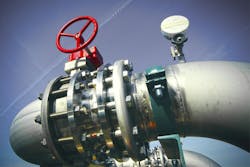The number of different flowmeters that can be applied to measure the flows of industrial liquids and gases can be overwhelming. Consider that there are more than a dozen potential flowmeter technologies (each of which has multiple variations and often many suppliers), so as many as 1,000 distinct flowmeters could be purchased in some applications. However, some services and applications can preclude the use of most technologies — leaving only a few options.
Such is the case of the measurement of process gases in large pipes in steel mills and other heavy industrial processes. These pipes often have diameters of more than perhaps 60 inches, but they can certainly be somewhat smaller. Further, most piping configurations have limited straight run that cannot be altered. Just think about the cost and real estate involved with providing many diameters of 60-inch pipe to develop a good velocity profile for your flowmeter. Components in coke oven gas and blast furnace gas services can coat the flowmeter and plug impulse lines. In addition, the "pipes" may be rectangular and operate at low pressures (only a few inches of water column) that can limit the pressure drop across the flowmeter.
Quickly eliminated are most differential pressure, magnetic, Coriolis mass, open channel, oscillatory, positive displacement, turbine and variable area flowmeters. Insertion flowmeters can pose accuracy problems in many installations and thermal flowmeters can coat in some applications. Remaining technologies include some differential pressure, some insertion, target and ultrasonic flowmeters, most of which require special design considerations and/or maintenance to remain in service.
The application presented may seem common — measure gas flow in a pipe — but it can quickly evolve into a much more complicated problem as additional constraints are added.
David W. Spitzer is a regular contributor to Flow Control magazine and a principal in Spitzer and Boyes LLC, which offers engineering, seminars, strategic, marketing consulting, distribution consulting and expert witness services for manufacturing and automation companies. Spitzer and Boyes is also the publisher of the Industrial Automation INSIDER. He has more than 40 years of experience and has written more than 10 books and 350 articles about flow measurement, instrumentation and process control.
Spitzer can be reached at 845-623-1830 or via spitzerandboyes.com. Click on the "Products" tab to find his Consumer Guides to various flow and level measurement technologies.




